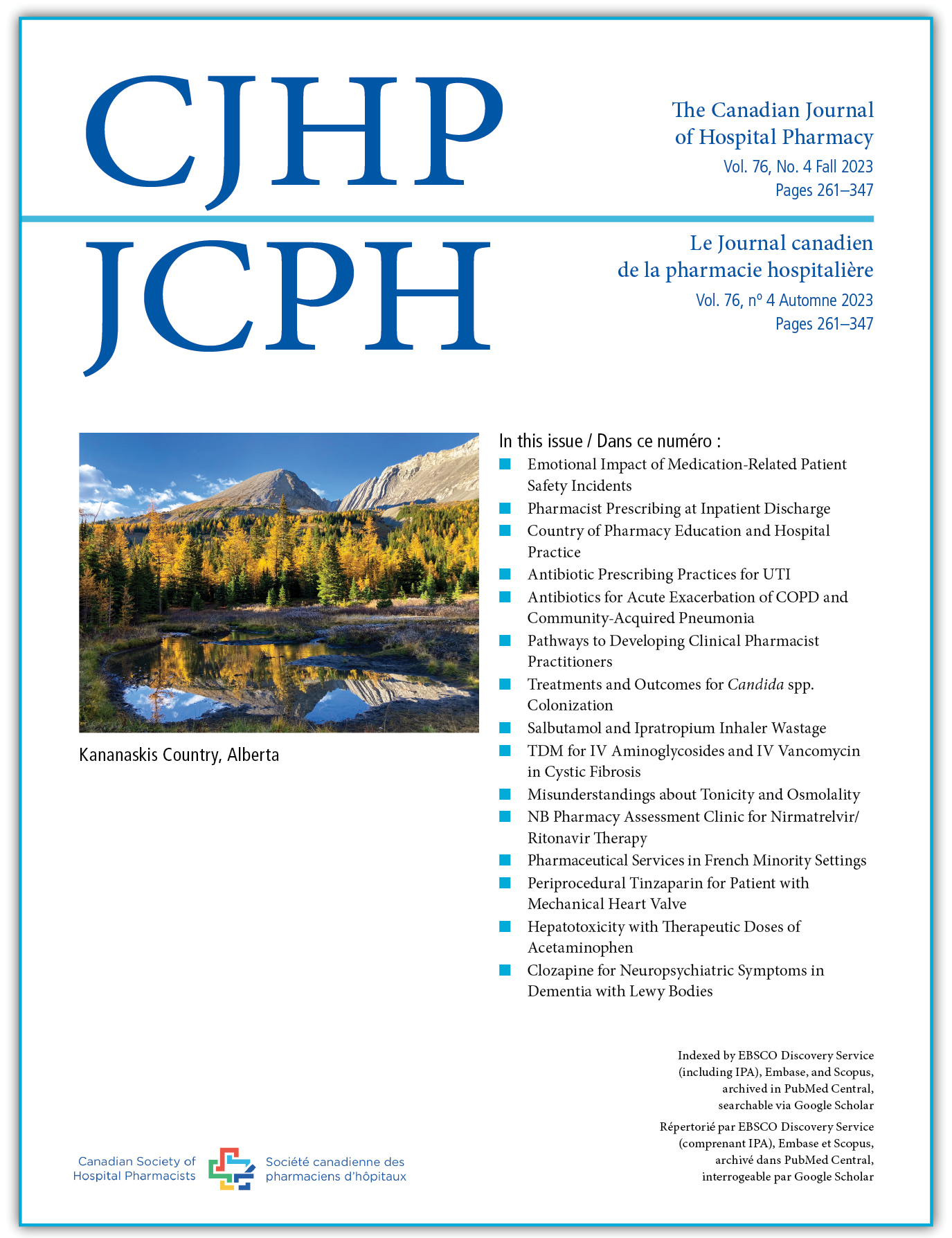Treatments and Outcomes of Critically Ill Patients with Candida spp. Colonization of the Lower Respiratory Tract in Regina, Saskatchewan
DOI:
https://doi.org/10.4212/cjhp.3408Abstract
Background: Among critically ill patients receiving mechanical ventilation, Candida spp. are commonly detected in the lower respiratory tract (LRT). This is generally considered to represent colonization.
Objective: To evaluate the use of antifungal treatments and the clinical outcomes of patients with Candida colonization of the LRT.
Methods: This retrospective analysis involved consecutive patients admitted to the intensive care unit between April 2016 and May 2021with positive results on Candida spp. testing of LRT samples. Data related to antifungal treatment and clinical outcomes were analyzed descriptively, and multivariable logistic regression was performed.
Results: Of 200 patients initially identified, 160 (80%) died in hospital. Antifungal therapy was given to 103 (51.5%) of the patients, with treatment being more likely among those with shock and those who received parenteral nutrition. Mortality was high among patients
with positive Candida results on LRT culture, regardless of treatment. Multivariable logistic regression, with adjustment for age, sex, comorbidities, and sequential organ failure assessment (SOFA) score, showed that antifungal treatment was associated with lower odds of death (odds ratio 0.39, 95% confidence interval 0.17–0.87) compared with no treatment (p = 0.021).
Conclusions: This study showed higher mortality rates than have been reported previously. Further investigation into the role of antifungal therapy among critically ill patients with Candida spp. colonization is required.
RÉSUMÉ
Contexte : Chez les patients gravement malades recevant une ventilation mécanique, les Candida spp. sont fréquemment détectées dans les voies respiratoires inférieures (VRI) – une situation généralement considérée comme une colonisation.
Objectif : Évaluer l’utilisation d’un traitement antifongique et les résultats cliniques chez les patients présentant une colonisation par Candida dans les VRI.
Méthodes : Cette analyse rétrospective portait sur des patients consécutifs de l’unité de soins intensifs ayant obtenu un résultat positif au test de Candida sur les isolats des VRI entre avril 2016 et mai 2021. Les données relatives au traitement antifongique et aux résultats cliniques ont été analysées de manière descriptive, et une régression logistique multivariable a été effectuée.
Résultats : Parmi les 200 patients initialement recensés, 160 (80 %) sont décédés à l’hôpital. Une thérapie antifongique a été administrée à 103 (51,5 %) des patients, et le traitement était plus probable chez ceux en état de choc et ceux ayant reçu une nutrition parentérale. Les patients ayant été déclarés positifs pour la Candida dans la culture des VRI présentaient un taux de mortalité élevé, indépendamment du traitement. Une régression logistique multivariable, avec ajustement pour l’âge, le sexe, les comorbidités et le score SOFA (sequential organ failure assessment), a montré que le traitement antifongique était associé à une probabilité de décès réduite (rapport de cotes 0,39; intervalle de confiance à 95 % 0,17-0,87), par rapport à l’absence de traitement (p = 0,021).
Conclusions : Cette étude a révélé des taux de mortalité plus élevés que ce qui avait été rapporté précédemment. Une enquête plus approfondie sur le rôle de la thérapie antifongique chez les patients gravement malades présentant une colonisation par Candida spp. est nécessaire.
Downloads
Published
Issue
Section
License
Copyright © Canadian Society of Healthcare-Systems Pharmacy.
After publication of a manuscript in the CJHP, the authors of the manuscript must obtain written permission from the CSHP (publications@cshp.ca) before reproducing any text, figures, tables, or illustrations from the work in future works of their own. If a submitted manuscript is declined for publication in the CJHP, all said rights shall revert to the authors. Please note that any forms (e.g., preprinted orders and patient intake forms) used by a specific hospital or other health care facility and included as illustrative material with a manuscript are exempt from this copyright transfer. The CJHP will require a letter from the hospital or health care facility granting permission to publish the document(s).










